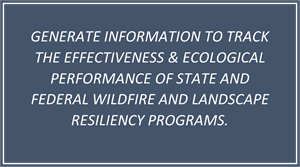
In support of CNRA’s multiple mandates to monitor fire-adapted ecosystems and evaluate the impact and effectiveness of management across watersheds and landowner types, the WERK project aims to generate novel, updatable, high resolution, wall-to-wall datasets for California’s fire-adapted ecosystems. The project will synthesize datasets from other sources to track land cover change and management actions and contextualize statewide ecological condition, disturbance, and recovery. These new data will then be integrated into the project’s follow-on effectiveness assessments to better determine how vegetation management writ large interacts with wildfire and other ecosystem changes, providing the State and federal agencies spatially explicit, updatable data to continually evaluate how their programs and projects are affecting entire landscapes in the context of a changing climate.
Mandates:
The State of California is required to assess ecological performance, impact, and effectiveness of its various programs charged with management and oversight of fire-prone landscapes. Among the programs that require these assessments are the Timber Regulation and Forest Restoration Program (AB 1492 [2012]) and various State programs implementing vegetation management for wildfire risk reduction (AB 203 [2022]). Under AB 1757 (2022), the State is required to track progress and measure outcomes of nature-based solutions targets set in April 2024, including several related to fire-prone landscapes.
Resources, Funding, Deliverables:
 \With significant funding from the State Legislature, the California Natural Resources Agency (CNRA) has invested in making remote sensing data and analytics publicly available for use in ecosystem health and wildfire management, along with related public safety and science applications across the state’s fire-prone landscapes. These investments will revolutionize how California utilizes science to track and mitigate the negative impacts of extreme environmental variability including catastrophic wildfire.
\With significant funding from the State Legislature, the California Natural Resources Agency (CNRA) has invested in making remote sensing data and analytics publicly available for use in ecosystem health and wildfire management, along with related public safety and science applications across the state’s fire-prone landscapes. These investments will revolutionize how California utilizes science to track and mitigate the negative impacts of extreme environmental variability including catastrophic wildfire.
The California Air Resources Board (CARB) and CNRA are working jointly with NASA Ames Research Center to utilize their supercomputing capabilities to develop cutting-edge remote sensing-based vegetation mapping products, tailored to California ecosystems. Using high-resolution data, this project will establish a thorough and up-to-date understanding of spatial and temporal ecosystem changes across California. The WERC project will create new metrics to monitor the state’s ecosystems and evaluate the impact management actions are having.
The primary data products include:
- Change Detection & Attribution | Maps and related assessments of where wildfires, forest and fire management, restoration, and other disturbance (e.g., drought or insect induced mortality events) have occurred throughout California
- Land Cover Classification & Mapping | High-resolution land cover classification maps to improve understanding of vegetation in California
- Individual Tree Monitoring | Tree canopy delineation maps using high-resolution imagery
- Built Structure Mapping | Polygon representation of structure maps (e.g., habitable dwellings, accessory structures, and industrial/commercial buildings)
Leveraging these data as well as other datasets, the WERK project will integrate data on reported and remotely sensed management activity and ecosystem changes (water quality and supply, biodiversity, biomass, etc.) to develop comprehensive, updatable, and accurate accounting and contextualization of statewide ecological condition, disturbance, and recovery. This will include new wildfire severity metrics, improved biomass quantification, improved tree die-off detection and quantification, and impact and effectiveness assessments. Data will be aggregated within and across geographies (e.g., HUC 12, counties, ecoregions, etc.), and analyses will be performed to link drivers of change to disturbance events and outcomes, as well as broader ecosystem condition change. For example, these analyses will enable the State to better gauge how management (fuel reduction treatments, commercial timber harvest, etc.) interacts with wildfire and other ecosystem changes. These assessments will allow the State and federal agencies to evaluate how their programs have affected entire landscapes – not just within project boundaries.

While data refresh frequency will vary depending on the specific product, it is expected many products will be updated annually.
Sustainability:
These data and assessments will be maintained by CARB’s Nature-Based Strategies team to transform the WERK project into an enduring monitoring program in partnership with CNRA. Information generated will provide new means for monitoring and assessing the progress of California’s wildfire and climate resilience programs. These data will become available starting in 2025 and will strengthen the State’s ability to monitor progress toward the State’s newly established nature-based solutions targets.
Who to Contact:
To learn more, contact Loretta Moreno, Environmental Program Manager of the Timber Regulation and Forest Restoration Program, CNRA: Loretta.Moreno@resources.ca.gov.



